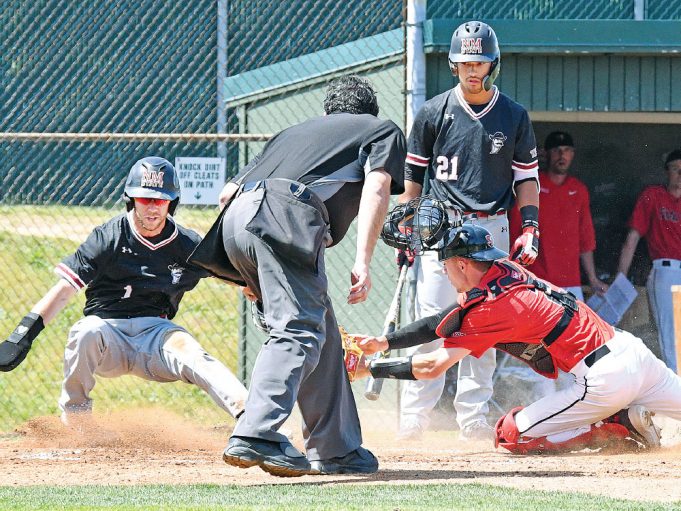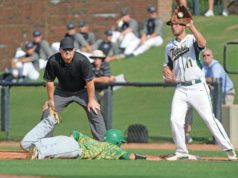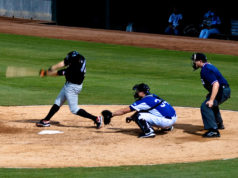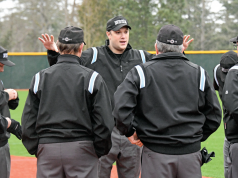In order to legally score a run, a runner must touch the plate, the same as the requirement to touch any other base. However, because the runner’s journey is seemingly over when he reaches home, there are special rules that apply. It’s OK for teammates to tell the runner to go back and touch the plate but they cannot assist him in returning, such as shoving him toward the plate or by grabbing him to stop his departure. There have been cases where spectators have pointed out the infraction to the defense and prompted an appeal; there is no rule prohibiting that.
There are two general scenarios in which runners may miss the plate. They are evading a tag and celebrations. Except where noted, the material applies equally to NFHS, NCAA and pro rules.
Evading a tag.
A runner who misses the plate after overrunning or oversliding it may return to touch it (NFHS 8-2 Nt.; NCAA 8-6a4; pro 5.09b12). If the runner immediately makes an effort to touch the plate, he is out only when he is tagged. If he starts toward the dugout or his position, he is out when he is tagged or the plate is tagged and appealed. Under NFHS rules only, such a runner cannot return once he enters the dugout (8.2.2M).
Play 1:
With a runner on second, B1 singles. R2 attempts to score and there is a close play at the plate. F2 misses the tag as R2 misses the plate. F2 jumps up quickly, steps on home plate and yells, “I’m appealing!” as he fires to second to prevent B1’s advance. As F2 appealed, R2 was (a) scrambling back to the plate, or (b) heading for the dugout. Ruling 1: In (a), R2 is not out and the run counts. F2 would have had to tag him. In (b), it is an appeal play and R2 is out since he left the plate area heading for his dugout.
Also, a runner who misses the plate cannot return once a following runner has scored. The third out does not preclude a return as an appeal can be made any time before the defensive team leaves the field. That means before the pitcher and all fielders have crossed the foul lines and before the catcher has left his position on the way to the bench. The run counts unless a proper appeal is made. Either the plate or the runner can be tagged on the appeal (NFHS 8-2 Pen., 8-2-3; NCAA 8-6, 8-6a3 Nt. 1; pro 5.09c2 AR).
Play 2:
With two out, R2 scores from second on B1’s single, but fails to touch the plate. B1 becomes the third out when he tries to go to second. Right after the out, R2 returns and touches the plate. Ruling 2: Legal. The run scores and the missed base cannot be appealed after R2 touches it.
When a runner slides past the plate without touching it and without being tagged, the umpire should not signal. In Game 4 of the 2009 World Series, Ryan Howard of the Phillies advanced from second on a Pedro Feliz single in the bottom of the fourth. He slid into Yankees catcher Jorge Posada and never touched the plate. The Yankees apparently did not recognize the miss and after a brief pause plate umpire Mike Everitt gave a weak safe signal.
Passing the plate.
Once a runner passes the plate, he gets credit for reaching it. The interpretation is the runner’s entire body must pass the entire base. In that case, his run counts unless a proper appeal is made.
In a men’s league game played under pro rules, there were runners on first and third with one out. B4 hit a home run and R3 touched home. R1 approached the plate and thinking he touched it, he pulled back down the third-base line to give a high-five to B4. The umpire saw R1 did not touch the plate and ruled he did not advance past the base. The plate man called out B4 for passing R1. He then mistakenly allowed the opponents to make a verbal appeal and called R1 out for missing the plate.
Celebrations.
The second general scenario in which a runner might miss the plate is some form of celebration and is most likely after a home run, especially a walk-off homer. In a prep game, the overjoyed teammates left a path to the plate for the hometown hero, but he chose to do a belly flop over the plate and into the scrum. The announcer pointed out the error when he saw the plate umpire was standing fast.
When a walk-off home run is hit, pandemonium reigns and the umpire’s task of ensuring all runners touch the plate becomes more difficult. Restrictions on celebrations are usually waived. The umpire must watch the batter-runner until he is reasonably certain the plate has been touched. In non-walk-off scenarios, the umpire must enforce the applicable rule, if for no other reason than to prevent a reoccurrence. Here is a case from a 2019 prep game where an impulsive umpire decided to fabricate a rule.
In the fifth inning, a visiting team home run hitter was called out because he got high-fived by a teammate before touching the plate. Remarkably no one was ejected over the bizarre call. Perhaps the fact the score was 18-2 in favor of the visitors influenced their coach to avoid a confrontation. The umpire’s rationale was he had to call the out to avoid setting a precedent for players obscuring the umpire’s view of the batter-runner touching the plate. Subsequent investigation revealed the plate umpire was a cousin of the pitcher who gave up the home run. Under NFHS and pro rules, no violation occurred, but the umpire could certainly warn players to not overcrowd the plate. NFHS rule 3-3-1a prohibits non-participating players from leaving the dugout while the ball is live, but in this case the ball was obviously dead.
NCAA rule 5-2d prohibits an offensive team member, other than the base coaches, from touching the batter-runner before home plate has been touched. Team personnel, except for preceding baserunners and the on-deck batter, are not allowed to leave the warning track area in front of the dugout (a recommended minimum area of 15 feet) to congratulate the batter-runner and other baserunners. The penalty is a warning for the first offense and ejection of one of the offending players for a subsequent violation.
Another celebration scenario is when the batter-runner rips off his helmet before scoring. That is not a violation in any code, but is worthy of a team warning in NFHS if the ball is live (1-5-1 Pen.).
What's Your Call? Leave a Comment:
Note: This article is archival in nature. Rules, interpretations, mechanics, philosophies and other information may or may not be correct for the current year.
This article is the copyright of ©Referee Enterprises, Inc., and may not be republished in whole or in part online, in print or in any capacity without expressed written permission from Referee. The article is made available for educational use by individuals.


















